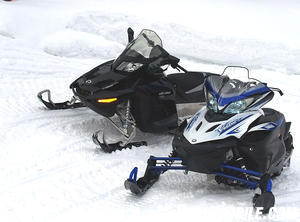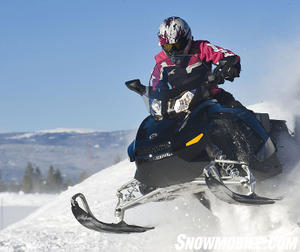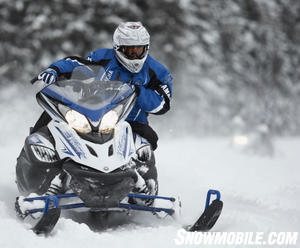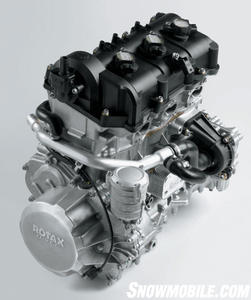Ski-Doo GSX 1200 vs Yamaha Vector

Ski-Doo counters Yamaha’s 4-stroke advantages with a 4-stroke of its own
If you go strictly by the numbers, Ski-Doo’s GSX Limited and Yamaha’s Vector ER share much in common. It’s when you take them off on the snow that they reveal different personalities. Which is better? What do you want from your sled?
The Ski-Doo GSX Limited brings the latest REV platform to personal sports riding. It’s light, nimble and as you’d expect from a GSX Limited, loaded with nice-to-have amenities. For 2009 Ski-Doo adds an all-new 1171cc 4-stroke triple that puts out 130-horsepower — give or take a few ponies.
4-stroke Sales
It’s easy for Ski-Doo to ratchet up the ‘we’re better’ hype because it’s had a few winters to figure out how to best target Yamaha’s Vector. Don’t kid yourself, when the competition began to realize just how successful Yamaha has become with its 4-stroke only sled policy, they all knew they would have to respond. The sales numbers don’t lie. Those numbers were showing a steady — although slower than Yamaha liked — move from 2-stroke sleds to Yamaha 4-strokes. Even though it had the promise of Evinrude-based clean 2-stroke technology coming for its popular 600cc Rotax twin, Ski-Doo rightly recognized that it would have to match Yamaha 4-stroke for 4-stroke to retain its customers. The Rotax 1200 4TEC should counter the Vector triple nicely.
 Ski-Doo’s new 4stroke GSX offers an alternative to Yamaha’s popular Vector.
Ski-Doo’s new 4stroke GSX offers an alternative to Yamaha’s popular Vector.
Genesis 120 Based
While it has yet to appear in a Vector chassis, Yamaha’s new Venture GT engine is another Vector-based triple. The new Genesis 120 FI is a fuel-injected iteration programmed to run low revs with high torque. This touring motor fits between the standard Genesis 120 carb engine and the Nytro’s performance triple. The Venture motor adds six-horsepower and is claimed to have a five-percent edge in fuel economy over the base Vector. The simple fact that the Venture engine mounting is extremely similar to the Vector’s might suggest an upgrade to this new motor for a redesigned 2010 issue of Yamaha’s Vector series.
We won’t bet against that, nor will we expect Ski-Doo to sit idly by while Yamaha continues to gobble up the lion’s share of 4-stroke sales.
That’s precisely why, for 2009, you can have a lightweight Ski-Doo with the all-new 600cc E-TEC 2-stroke twin, or a not quite as lightweight Ski-Doo with an all-new 4TEC triple cylinder motor. This new 4-stroke Rotax not only mimics Yamaha’s Genesis 120 triple, but the performance is on a par with the popular Vector engine. Although the target was the carbureted Genesis 120, the brand new Rotax 4-stroke actually compares better to the new Venture’s Genesis 120FI.
Rotax 4-strokes
 The new REV-chassis with 4stroke GSX is a sporty ride.
The new REV-chassis with 4stroke GSX is a sporty ride.
In sled-to-sled comparisons on Colorado trails this past March, the Rotax triple with double overhead cams, four valves per cylinder and ample mouthed 52mm throttle body fuel injection claimed the performance edge. Fuel injection means crisper throttle response and there was a noticeable difference with the GSX versus Vector ER. Then again, the Ski-Doo with its REV chassis carries 30 less pounds than the Vector.
Best Values
We still feel that the base Vector is one of the best values in snowmobiling. It doesn’t have the brutally quick response of the 4-cylinder Apex coming off a turn, but through a snaky section of trails, it can be more fun to ride. Because the drive system is direct from crank to clutch and because the Genesis 120 was designed to be a snowmobile motor with grunt and midrange guts, the power delivery is very smooth. The Apex motor is based on the ‘R-Series’ motorcycle quad cylinder and its high revs are ‘stepped down’ to make it clutch-able. It is plenty potent, but the Vector is more drivable mile after mile.
The new Rotax-powered GSX is similar to the Vector in drivability. We figure that Ski-Doo has given its fans a reason to stay loyal. The same 4-stroke advantages that Yamaha claims for the Vector apply to the GSX models. There are the lowered emissions, better mileage, cleaner running, and zero 2-stroke oil ‘smell.’
When you check the specifications, you’ll find that both the Ski-Doo and the Yamaha are close. There’s long travel suspension up front with high-pressure gas shocks controlling the travel of the double A-arms. The rear suspensions feature gas shocks. Of course, the Vector offers its nifty remote adjuster on the side of the tunnel. Then again, Ski-Doo counters with the SC-5 iteration of its rear suspension.
Ride Differences
 The Vector is a great everyday snowmobile for cruising or sport.
The Vector is a great everyday snowmobile for cruising or sport.
If you are a very aggressive rider, the Vector might suit you better. The reality is that if you are a truly aggressive rider, you’ll pop for a Nytro or an MXZ. We give the GSX the edge in overall high-mileage comfort. It’s a very easy sled to like for all day cruising. Unlike previous GSX models, the new wider-bodied REV chassis used with the 4-stroke engine makes it an excellent everyday choice.
When it comes to choosing between the GSX and Vector, we figure Ski-Doo holds a slight advantage with its fuel-injected triple and what we feel is a better riding position for long distances. Yamaha’s remote adjuster for the rear suspension is a definite plus for the Vector. The Yamaha also should have a bit better bite in loose snow as you get a more aggressive Rip Saw track with 1.25-inch lug profile compared to the one-inch lug profile standard on the GSX. Otherwise these sleds are a virtual toss-up as to base features. Both models compare well for ‘livability.’
Comparing
 Ski-Doo offers a serious 4stroke alternative to Yamaha’s Genesis 120.
Ski-Doo offers a serious 4stroke alternative to Yamaha’s Genesis 120.
You could upgrade to the Vector GT and get premium ‘clicker’ front shocks and the electronic speedometer and infinite adjustable hand warmers for US$400 more. That’s still comfortably less than the 4-stroke GSX Limited.
Either of these sleds would be a good choice for everyday riding. The 4-stroke engines are quite comparable. Although the Vector triple has a known and solid history, we expect similar longevity and durability from the new Rotax 1203 design. When it comes to on-trail manners they are both very good snowmobiles. As noted the Ski-Doo gets our edge for ride and the Yamaha seems to handle a bit better for the more aggressive rider.
For Ski-Doo, this new 4-stroke should be enough to keep most loyal Ski-Dooers out of Yamaha dealerships. But Yamaha has gotten everyone’s attention with its commitment to building fun, well-priced 4-stroke-powered snowmobiles. Now, though, Ski-Doo offers an alternative with a 4-stroke option of its own.
Specs Comparison:
| 2009 Ski-Doo GSX Limited | 2009 Yamaha Vector ER | 2009 Yamaha Vector GT | |
| Engine | Rotax 1171cc Triple; Throttle Body Fuel Injection | Yamaha Genesis 120 973cc Triple; 3x40mm Keihin carbs | Yamaha Genesis 120 973cc Triple; 3x40mm Keihin carbs |
| HP | Approx 130 | 120 | 120 |
| Drive | TRA IV | YVXC | YVXC |
| Front Susp. | Dual A-arm — 9 in travel; Kayaba HPG | Double Wishbone — 9 in travel: 36mm KYB Aluminum body, high pressure gas | Double Wishbone — 9 in travel: 40mm GYTR dual clicker Aluminum body, high pressure gas |
| Rear Susp. | SC-5 — 15 in maximum travel; Front Arm: Kayaba HPG, Rear Arm: Kayaba HPG VR | MonoShock RA — 11.6 in travel; 46mm KYB with remote adjustment | MonoShock RA — 11.6 in travel; 46mm KYB with remote adjustment |
| Length | 113.8 in | 108.5 in | 108.5 in |
| Height | 52.2 | 45.7 | 45.7 |
| Width | 47.9 | 48.2 | 48.2 |
| Ski Stance | 47.0 | 42.7 | 42.7 |
| Track | 15 x 120 x1.0 Ripsaw | 15 x 121 x 1.25 Ripsaw | 15 x 121 x 1.25 Ripsaw |
| Weight | 539 lbs | 570 lbs | |
| Fuel Tank | 10.6 US Gal | 9.6 US Gal | 9.6 US Gal |
| Price | $10,500 | $9,399 | $9,699 |
Related Reading:
2009 Ski-Doo Preview
2009 Yamaha Preview








 Your Privacy Choices
Your Privacy Choices